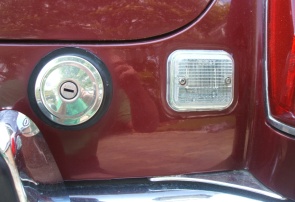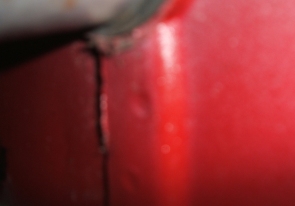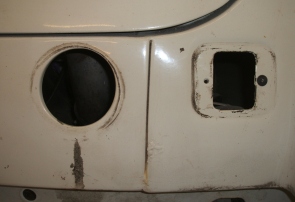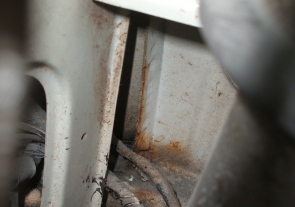445
Different rear panel joints on Factory
MGBGTV8s
An interesting thread came up on the V8 Bulletin Board at the
end of April 2012 on body panel joints from Michael O'Leary who is restoring a
1974 Factory MGBGTV8. (May
12)
Michael
O'Leary said "does anyone know if joints should be visible between the
rear valance and the rear wings of any age of MGB - that is a visible line near
the petrol filler cap and at the side underneath the ends of the bumpers, mirrored
on both sides? I have a 1974 model where they're visible but a 1973 model that
are not! I'm assuming they've been filled over on the 1973 model but I also know
MG often changed how they built the cars - for example 1980's cars had a joint
visible on the front windscreen pillar of GTs. Any help would be appreciated."
Mike Howlett replied "all MGBGTs have joints across both A and
C posts, and also on the rear panel, near the fuel filler and in the equivalent
position on the left side of the car. Up until about 1973 these joints were filled
with lead/tin solder so they were invisible. After that the joints were not filled,
possibly to save a little money in the production. The joint on the C-post was
simply covered with a badge - you will notice that earlier GTs have no badge and
that's why - they don't need one." Mike added "the joint on the lower
panel behind the rear wheel arch (under the bumper) is always visible on all ages
of the car."
Stuart Ratcliff, an MGV8 specialist in Sydney
Australia, added "it is easy to tell if your vehicle had visible joints or
not. On the rear panel below the boot lid the joints that were leaded are lap
joints while on later cars the joint consists of two folded in flanges that are
spot welded together on the inside and filled with seam sealer on the outside.
Probably a health and safety issue about the use of lead but more likely a cost
issue with no need for skilled body men to do the lead work. Replacement body
panels cause a problem as the joints are actually in a different place on leaded
and unleaded joint vehicles so you may end up with a vehicle with two lots of
joints if the rear panel has been replaced. Leaded and unleaded joints are also
used on the joint between the rear guard and the rear panel behind the cockpit
on the roadster again lap or flanged joints."
Michael O'Leary
replied saying "Stuart, I've just compared the two cars within the boot and
see what you mean. As Mike said it must have been 1973 when they changed the detail.
At the risk of being too anal; the outer sill of the 1974 car has five regular
shaped water release profiles but the 73 car has two smaller profiles at the each
end then three larger profiles in between. Is that another change from about that
time?
At this point the V8 webmaster asked Michael if he could let us
have some photos of these detailed points so they could be popped on the V8 website
in A4 PDF format so fellow members will be able to follow this interesting point?
Michael very kindly provided the photos alongside within a couple of hours.
Jon Moulds said "did the C post badges really come in 1973? My
May '75 V8 doesn't have them and I know it's wearing it's original coat of paint.
I've had plenty of '74 V8s that didn't have a C post badge either."
Stuart Ratcliff added "In his book Original MGB Anders Clausager mentions
the change to later type joints as being started at MGB Roadster 360301, GT 361001
and V8 2101 (Sept 1974) - in other words at the start of Rubber Nose production.(production
changes on page 148). The leading of the GT roof joints is mentioned as being
deleted at vehicle 401000 which meant that bodies were completed at Swindon without
the need for them to be moved to Cowley where lead loading was carried out. I
know early rubber nose V8s had no rear pillar badge as I have fitted them to cover
cracked lead joints on customer cars!
David Knowles then provided a clarification saying "The changes
were phased in over a period around 1974, but not all at once. There were a number
of reasons - cost was a big part of it but also the fact that in the UK, the 'HASAWA'
or 'Health & Safety at Work Act 1974' was an important piece of new legislation
and | 
1973 Factory MGBGTV8 in Damask (external/internal)


1974 Factory MGBGTV8 in Glacier White undergoing restoration

certain industrial practices, such as lead loading, were becoming harder
to achieve in a factory without the mild inconvenience of risking the death of
members of the workforce. The first to go were the rear panel seams - and when
my own V8 was restored the body man had to create some infill bits to bridge the
gap between the old rear panel and the new BMH rear wings (he had cut away the
old rear wings before checking the dimensions!). That car is of course Damask
1215, a spring 1974 car. I remember many years ago first seeing a late chrome
bumper car with visible vertical seams and thinking at first it had been restored
wrongly. On all 'rubber bumper' cars these vertical seams should be visible. On
the 'C' pillars, the early 'rubber bumper' cars stuck with a filled roof/pillar
joint until the 1976 model year, when a neat little plated 'mazak' badge with
a little 'GT' logo cast in was introduced. This was styled by the future Director
of Rover Design, Gordon Sked."
Mike Howlett thanked David
"for giving us the full story - I didn't realise the C-post seam didn't get
its badge until so late. I know the seams on my 1969 GTV8 conversion are lead
loaded because when I was welding on a new rear valance the lead started to drip
out of the seam!"
See our illustrated A4L PDF note online for better
copies of these photos. More |



